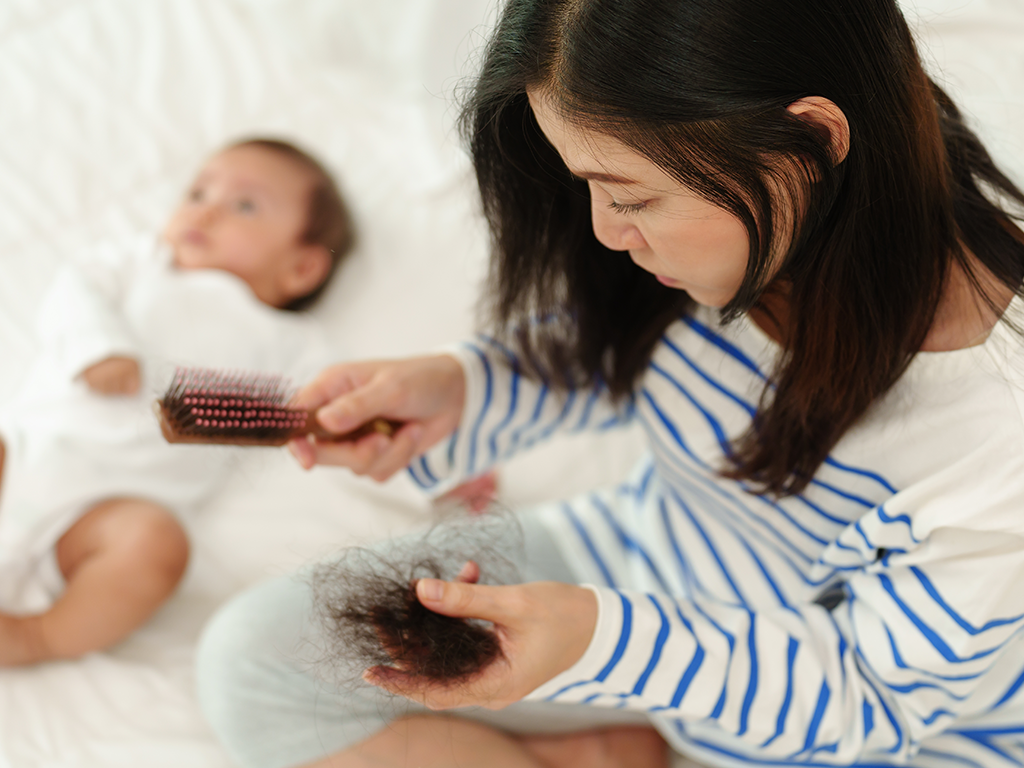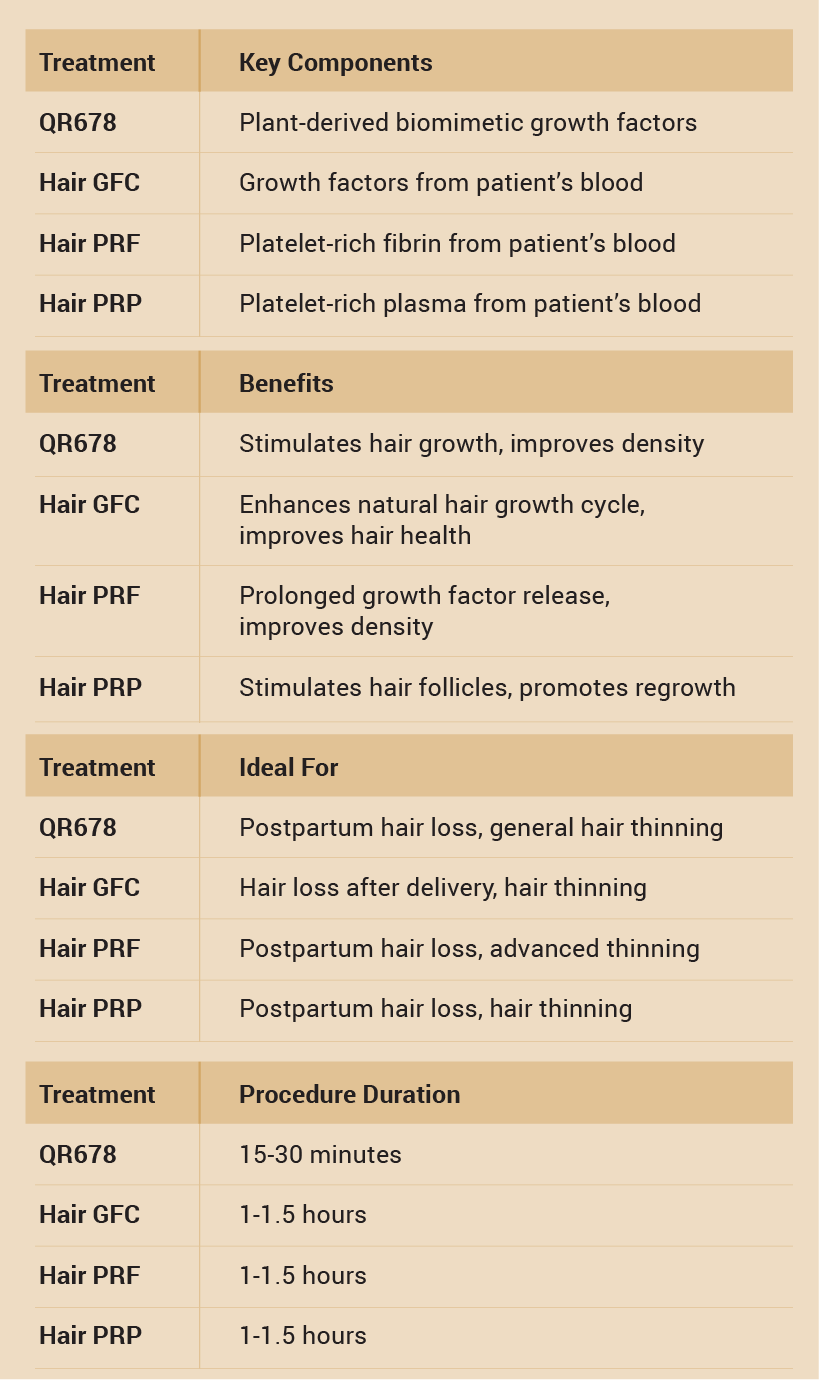
How to stop postpartum hair loss?
Postpartum hair loss, also known as post-pregnancy hair loss, affects 40%-50% of new mothers. This condition, characterised by excessive hair shedding, can be distressing for many women after childbirth. Understanding how to stop hair loss after pregnancy and exploring effective treatments is crucial for regaining your confidence and healthy hair.
In this blog, we will discuss various postpartum hair loss treatments that are safe for breastfeeding mothers, what causes postpartum hair loss & how it can be managed
3 Postpartum hair loss treatments by trichologist
QR678®️
QR678®️ is an innovative, non-surgical treatment designed to combat hair loss, including postpartum hair loss. It involves injecting a unique mixture of plant-derived biomimetic polypeptides that imitate human growth factors into the scalp, which stimulates hair growth and improves hair density.
QR678®️ can significantly help with hair regrowth after pregnancy by providing essential nutrients directly to the hair follicles. This treatment promotes healthier, stronger hair growth and reduces hair fall post-pregnancy.
Hair GFC
GFC, or Growth Factor Concentrate, is a treatment that utilises the growth factors derived from a patient’s blood. The concentrate is then injected into the scalp to stimulate hair growth and improve hair health.
Hair GFC can effectively address hair loss after delivery by enhancing the natural hair growth cycle and boosting the overall health of the hair follicles. This treatment helps to control hair fall after pregnancy and encourages new hair growth.
Hair PRF & PRP
PRP, or Platelet-Rich Plasma, is a treatment that involves drawing a small amount of the patient’s blood, processing it to concentrate the platelets, and then injecting it into the scalp. Platelets contain growth factors that stimulate hair growth and improve hair health.
PRF, or Platelet-Rich Fibrin, is similar to PRP but includes a higher concentration of platelets and fibrin. PRF releases growth factors more slowly, providing prolonged stimulation to the hair follicles.
Both PRP and PRF treatments can significantly help with postpartum hair loss by stimulating the hair follicles and promoting hair regrowth. These treatments are particularly effective in reducing hair fall after pregnancy and improving hair density.
Which is the right hair loss treatment for you?
Choosing the right treatment for postpartum hair loss depends on various factors, including the extent of hair loss and individual preferences. Sometimes, a combination of these treatments can yield the best results.
Our trichologists and aesthetic dermatologists can tailor a personalised treatment plan based on your specific needs and the severity of your hair loss. Here’s a comparison of the different treatment options:


By consulting with our experts, you can determine the most effective approach to addressing your postpartum hair loss and achieve the best possible outcomes.
What is postpartum hair loss?
Postpartum hair loss, also known as postpartum hair fall, is the shedding of hair experienced by many women after childbirth. This condition typically occurs a few months after delivery and can last up to a year. It is a temporary phase where the hair shifts from the growing phase to the shedding phase more rapidly than usual.
What causes postpartum hair loss?
The primary cause of postpartum hair loss is hormonal changes. During pregnancy, elevated levels of oestrogen prolong the growth phase of the hair. After childbirth, oestrogen levels drop, causing a significant number of hairs to enter the shedding phase simultaneously. Other factors contributing to hair loss after pregnancy include stress, nutritional deficiencies, and thyroid imbalances.
Can postpartum hair loss be prevented?
While it may not be entirely possible to prevent postpartum hair loss, certain measures can help minimise its impact:
- Healthy Diet: Ensure you have a balanced diet rich in vitamins and minerals, which are crucial for hair health.
- Gentle Hair Care: Avoid harsh treatments and opt for gentle shampoos and conditioners.
- Stress Management: Practise stress-reducing techniques like yoga and meditation.
- Regular Check-ups: Monitor thyroid levels and address any deficiencies with your healthcare provider’s guidance.
Takeaway
Postpartum hair loss can be a distressing experience, but understanding the available treatments can help you regain healthy, beautiful hair. Whether you opt for QR678, Hair GFC, PRP, or PRF, consulting with a trichologist is the first step towards finding the right solution for you. Don’t let postpartum hair loss affect your confidence—book an appointment with a specialist today and take the first step towards reclaiming your hair’s vitality.
Book your consultation today Linto explore the best treatments for postpartum hair loss and regain your confidence with healthier, fuller hair.
Frequently Asked Questions
Yes, QR678®️ is generally considered safe for breastfeeding women. It is a non-surgical treatment that uses growth factors to stimulate hair growth without affecting lactation.
Yes, GFC is safe for breastfeeding women as it uses growth factors derived from the patient’s own blood, posing no risk to lactation or the baby.